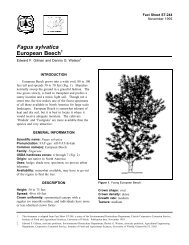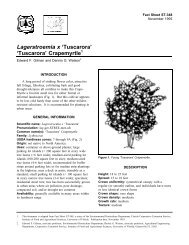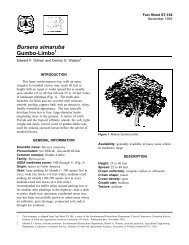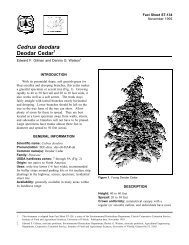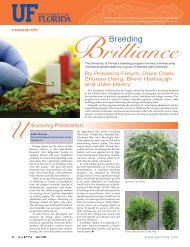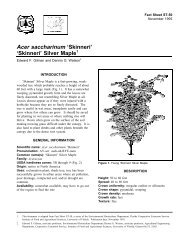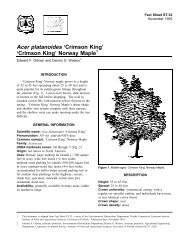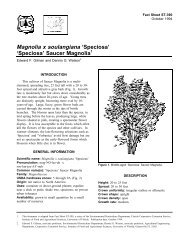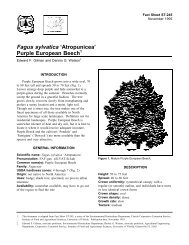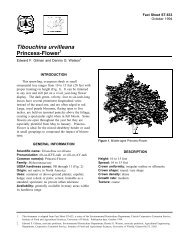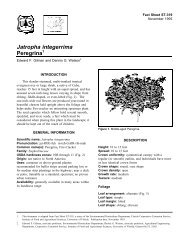Amelanchier x grandiflora Apple Serviceberry - Environmental ...
Amelanchier x grandiflora Apple Serviceberry - Environmental ...
Amelanchier x grandiflora Apple Serviceberry - Environmental ...
Create successful ePaper yourself
Turn your PDF publications into a flip-book with our unique Google optimized e-Paper software.
<strong>Amelanchier</strong> x <strong>grandiflora</strong><br />
<strong>Apple</strong> <strong>Serviceberry</strong> 1<br />
Edward F. Gilman and Dennis G. Watson 2<br />
INTRODUCTION<br />
<strong>Apple</strong> <strong>Serviceberry</strong> is a hybrid between<br />
<strong>Amelanchier</strong> canadensis and <strong>Amelanchier</strong> laevis that<br />
grows 15 to 25 feet tall (Fig. 1). Multiple stems are<br />
upright and highly branched forming a dense shrub, or<br />
if properly pruned in the nursery, a small tree. It is<br />
superior to either species in that it suckers less and is<br />
adapted to a wide range of soils, and tolerates some<br />
drought. The main ornamental feature is the white<br />
flowers that are larger than those of other<br />
amelanchiers. The flowers are borne in early spring<br />
and are at first tinged with pink but later fade to white.<br />
The young leaves are purplish and the fall color is<br />
yellow to orange. Edible fruit attracts birds. Welladapted<br />
for planting beneath power lines due to its<br />
small size.<br />
GENERAL INFORMATION<br />
Scientific name: <strong>Amelanchier</strong> x <strong>grandiflora</strong><br />
Pronunciation: am-meh-LANG-kee-er x<br />
gran-dih-FLOR-uh<br />
Common name(s): <strong>Apple</strong> <strong>Serviceberry</strong><br />
Family: Rosaceae<br />
USDA hardiness zones: 4 through 7 (Fig. 2)<br />
Origin: not native to North America<br />
Uses: container or above-ground planter; wide tree<br />
lawns (>6 feet wide); medium-sized tree lawns (4-6<br />
feet wide); recommended for buffer strips around<br />
parking lots or for median strip plantings in the<br />
highway; near a deck or patio; specimen; residential<br />
street tree<br />
Availability: somewhat available, may have to go out<br />
of the region to find the tree<br />
Figure 1. Middle-aged <strong>Apple</strong> <strong>Serviceberry</strong>.<br />
DESCRIPTION<br />
Fact Sheet ST-77<br />
November 1993<br />
Height: 15 to 25 feet<br />
Spread: 15 to 25 feet<br />
Crown uniformity: irregular outline or silhouette<br />
Crown shape: upright; vase shape<br />
Crown density: moderate<br />
Growth rate: slow<br />
Texture: fine<br />
1. This document is adapted from Fact Sheet ST-77, a series of the <strong>Environmental</strong> Horticulture Department, Florida Cooperative Extension Service,<br />
Institute of Food and Agricultural Sciences, University of Florida. Publication date: November 1993.<br />
2. Edward F. Gilman, associate professor, <strong>Environmental</strong> Horticulture Department; Dennis G. Watson, associate professor, Agricultural Engineering<br />
Department, Cooperative Extension Service, Institute of Food and Agricultural Sciences, University of Florida, Gainesville FL 32611.
<strong>Amelanchier</strong> x <strong>grandiflora</strong> -- <strong>Apple</strong> <strong>Serviceberry</strong> Page 2<br />
Figure 2. Shaded area represents potential planting range.<br />
Foliage<br />
Leaf arrangement: alternate (Fig. 3)<br />
Leaf type: simple<br />
Leaf margin: serrate<br />
Leaf shape: elliptic (oval); oblong<br />
Leaf venation: pinnate<br />
Leaf type and persistence: deciduous<br />
Leaf blade length: 2 to 4 inches; less than 2 inches<br />
Leaf color: green<br />
Fall color: orange; red; yellow<br />
Fall characteristic: showy<br />
Flower<br />
Flower color: white<br />
Flower characteristics: spring flowering; very<br />
showy<br />
Fruit<br />
Fruit shape: round<br />
Fruit length: < .5 inch<br />
Fruit covering: fleshy<br />
Fruit color: red<br />
Fruit characteristics: attracts birds; suited for human<br />
consumption; no significant litter problem; persistent<br />
on the tree; showy<br />
Trunk and Branches<br />
Trunk/bark/branches: bark is thin and easily<br />
damaged from mechanical impact; routinely grown<br />
with, or trainable to be grown with, multiple trunks;<br />
grow mostly upright and will not droop; showy trunk;<br />
tree wants to grow with several trunks but can be<br />
trained to grow with a single trunk; no thorns<br />
Pruning requirement: needs little pruning to develop<br />
a strong structure<br />
Breakage: resistant<br />
Current year twig color: brown<br />
Current year twig thickness: thin<br />
Culture<br />
Light requirement: tree grows in part shade/part sun;<br />
tree grows in full sun<br />
Soil tolerances: clay; loam; sand; acidic;<br />
well-drained<br />
Drought tolerance: moderate<br />
Aerosol salt tolerance: moderate
<strong>Amelanchier</strong> x <strong>grandiflora</strong> -- <strong>Apple</strong> <strong>Serviceberry</strong> Page 3<br />
Figure 3. Foliage of <strong>Apple</strong> <strong>Serviceberry</strong>.<br />
Soil salt tolerance: moderate<br />
Other<br />
Roots: surface roots are usually not a problem<br />
Winter interest: no special winter interest<br />
Outstanding tree: tree has outstanding ornamental<br />
features and could be planted more<br />
Invasive potential: little, if any, potential at this time<br />
Ozone sensitivity: tolerant<br />
Pest resistance: very sensitive to one or more pests<br />
or diseases which can affect tree health or aesthetics<br />
USE AND MANAGEMENT<br />
‘Cumulus’ - is moderately columnar, may sucker<br />
at the root collar; ‘Robin Hill’ has an upright habit, 20<br />
to 25 feet tall, sensitive to drought; ‘Autumn<br />
Brilliance’ is supposedly resistant to leaf spot.<br />
Pests<br />
Cambium miners cause concern when noticed but<br />
are not very damaging to the tree. The mines can<br />
extend from a twig all the way down to the roots. The<br />
mines are light colored lines in the bark. No controls<br />
are suggested.<br />
A leaf miner will mine leaves, particularly the<br />
lower half of the leaf. The mines are irregular in<br />
shape.<br />
The leaves of amelanchier are skeletonized by at<br />
least two insects. The first insect forms small cocoons<br />
on the undersides of leaves. Skeletonized leaves look<br />
as though they have windows in them after the insects<br />
scrape tissue off the top and bottom of the leaves.<br />
The second insect is the larva of the pear sawfly. The<br />
larvae are black to greenish black and look slimy.<br />
Adult sawflies lay eggs in May and June and again in<br />
August. Heavily skeletonized leaves drop off.<br />
Several borers attack amelanchier. Healthy trees<br />
are considered less susceptible so regular fertilization<br />
and watering during dry spells will help prevent borer<br />
attacks.<br />
Spider mites will feed on amelanchier. These<br />
insects are hard to detect as they are so small. The<br />
main symptom of mite injury is the loss of green leaf<br />
coloration. If the infestation is heavy, very fine<br />
webbing may be seen. Horticultural oil sprays help<br />
control mite infestations.<br />
Aphids of several types suck juices from<br />
amelanchier. Heavy infestations cause distortion of<br />
the foliage and new growth, and deposit large amounts<br />
of sticky honeydew on lower foliage. Black sooty<br />
mold will grow on the honeydew.<br />
Diseases<br />
Witches broom, also called black mildew, infects<br />
the growing point causing the formation of many<br />
stems. The cluster of stems is called the witches<br />
broom. Another symptom is a black fungal growth,<br />
coating the undersides of the leaves. The damage to
<strong>Amelanchier</strong> x <strong>grandiflora</strong> -- <strong>Apple</strong> <strong>Serviceberry</strong> Page 4<br />
the tree is usually not serious and the brooms can be<br />
pruned off. No chemical controls are suggested.<br />
Leaf blight can cause leaf drop when a severe<br />
infection occurs. The disease causes small purple<br />
spots on the leaves. The spots enlarge and turn brown,<br />
later a small black dot will be seen in the center of the<br />
spot. Large numbers of spots cause infected leaves to<br />
drop.<br />
Fire blight is characterized by the sudden wilting<br />
and death of branch tips. The blossoms wilt, blacken<br />
and hang on the twig. The bark is shriveled and has<br />
small bumps or blisters on it. Sometimes gum oozes<br />
out of the infected area and a crack forms between the<br />
diseased and healthy bark. Control with chemicals is<br />
difficult. Diseased branches should be pruned out.<br />
Make the cut at least four inches beyond the diseased<br />
area. Disinfect pruning tools with bleach between<br />
cuts. Fertilizing heavily with nitrogen increases<br />
susceptibility to fire blight.<br />
Powdery mildews of several types cause white<br />
powdery growth on the leaves of amelanchier. Late in<br />
the season no controls may be needed.<br />
Fruit rot be a problem in wet weather. The fruits<br />
are often eaten by birds so may not be around long<br />
enough to become diseased.<br />
Cedar rusts can be troublesome.



